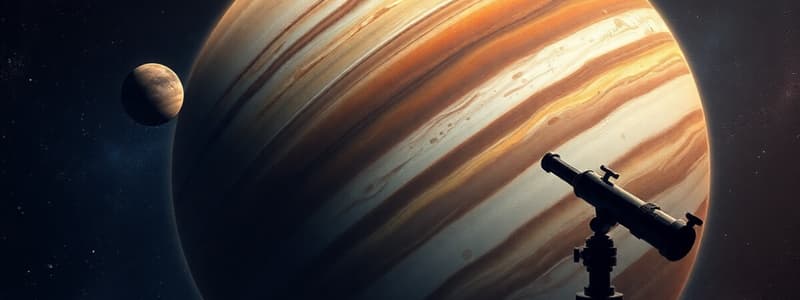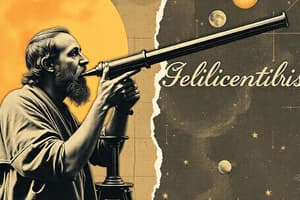Podcast
Questions and Answers
What major discovery did Galileo make with his observations of Jupiter?
What major discovery did Galileo make with his observations of Jupiter?
- He discovered the rings of Saturn.
- He discovered that Venus has phases.
- He discovered moons orbiting Jupiter. (correct)
- He discovered that Earth is the center of the universe.
What method did Galileo use to observe the moons of Jupiter?
What method did Galileo use to observe the moons of Jupiter?
- A microscope
- The naked eye
- A telescope (correct)
- A spectrometer
What change did Galileo notice regarding the small 'stars' he observed near Jupiter?
What change did Galileo notice regarding the small 'stars' he observed near Jupiter?
- Their positions relative to Jupiter changed. (correct)
- They changed color during the night.
- Their brightness increased over time.
- They appeared to disappear periodically.
What conclusion did Galileo draw from his observations of Jupiter's moons?
What conclusion did Galileo draw from his observations of Jupiter's moons?
Which of the following was NOT a feature observed by Galileo through his telescope?
Which of the following was NOT a feature observed by Galileo through his telescope?
How did Galileo's discoveries challenge the geocentric model?
How did Galileo's discoveries challenge the geocentric model?
What was one of the 'small stars' that Galileo discovered near Jupiter later known as?
What was one of the 'small stars' that Galileo discovered near Jupiter later known as?
What year did Galileo use the telescope for his astronomical observations?
What year did Galileo use the telescope for his astronomical observations?
What significant conclusion did Galileo make about the bodies he observed changing positions relative to Jupiter?
What significant conclusion did Galileo make about the bodies he observed changing positions relative to Jupiter?
How did Galileo's observations challenge the geocentric model of the universe?
How did Galileo's observations challenge the geocentric model of the universe?
What unique feature of Venus did Galileo observe that was similar to the Moon?
What unique feature of Venus did Galileo observe that was similar to the Moon?
What was one implication of Galileo discovering that a secondary celestial body could orbit a moving celestial body?
What was one implication of Galileo discovering that a secondary celestial body could orbit a moving celestial body?
Which statement best describes Galileo's view of the universe after his observations?
Which statement best describes Galileo's view of the universe after his observations?
What visual change in Venus did Galileo document during his observations?
What visual change in Venus did Galileo document during his observations?
Why were Galileo's findings about Venus and Jupiter's moons considered revolutionary?
Why were Galileo's findings about Venus and Jupiter's moons considered revolutionary?
What did Galileo’s discovery of moons orbiting Jupiter imply about the nature of celestial bodies?
What did Galileo’s discovery of moons orbiting Jupiter imply about the nature of celestial bodies?
Flashcards are hidden until you start studying
Study Notes
Galileo's Telescope Observations
- Galileo Galilei utilized the telescope, invented in 1609, to challenge geocentric beliefs.
- His observations led to significant discoveries regarding celestial bodies and their movements.
Moons of Jupiter
- Galileo discovered Jupiter’s largest moons by observing small "stars" near Jupiter.
- These "stars" changed positions over consecutive nights, indicating they were orbiting Jupiter.
- This finding suggested that not all celestial bodies revolve around the Earth, opposing the geocentric model.
Implications of Discoveries
- Galileo's findings implied that celestial bodies could orbit a moving planet, not just the Earth.
- This shifted the understanding of the cosmos and the structure of the solar system.
Phases of Venus
- Galileo observed that Venus displays a full set of phases akin to the Moon's cycle.
- He tracked Venus from a small crescent to a full shape, suggesting its orbit around the Sun, further disproving geocentrism.
Studying That Suits You
Use AI to generate personalized quizzes and flashcards to suit your learning preferences.



